Reflective Essay: Comprehensive Analysis of Risk Assessment Strategies
VerifiedAdded on 2023/04/21
|8
|1811
|382
Essay
AI Summary
This reflective essay delves into various aspects of risk assessment, including strategies for arm car lifts, chemical hazards, and the safety of children in manufacturing units. It emphasizes the importance of identifying hazards, assessing risks, and implementing preventative measures. The essay reflects on the significance of regular updates to risk assessment documents and the need for thorough employee evaluation regarding safety protocols. Furthermore, it highlights the role of sensible risk assessment in improving employee employability and preventing workplace accidents. The reflection includes practical applications such as chemical risk assessment using a risk assessment form and drafting recommendations for employee selection based on safety performance. This document is available on Desklib, a platform offering a wide range of solved assignments and study tools for students.
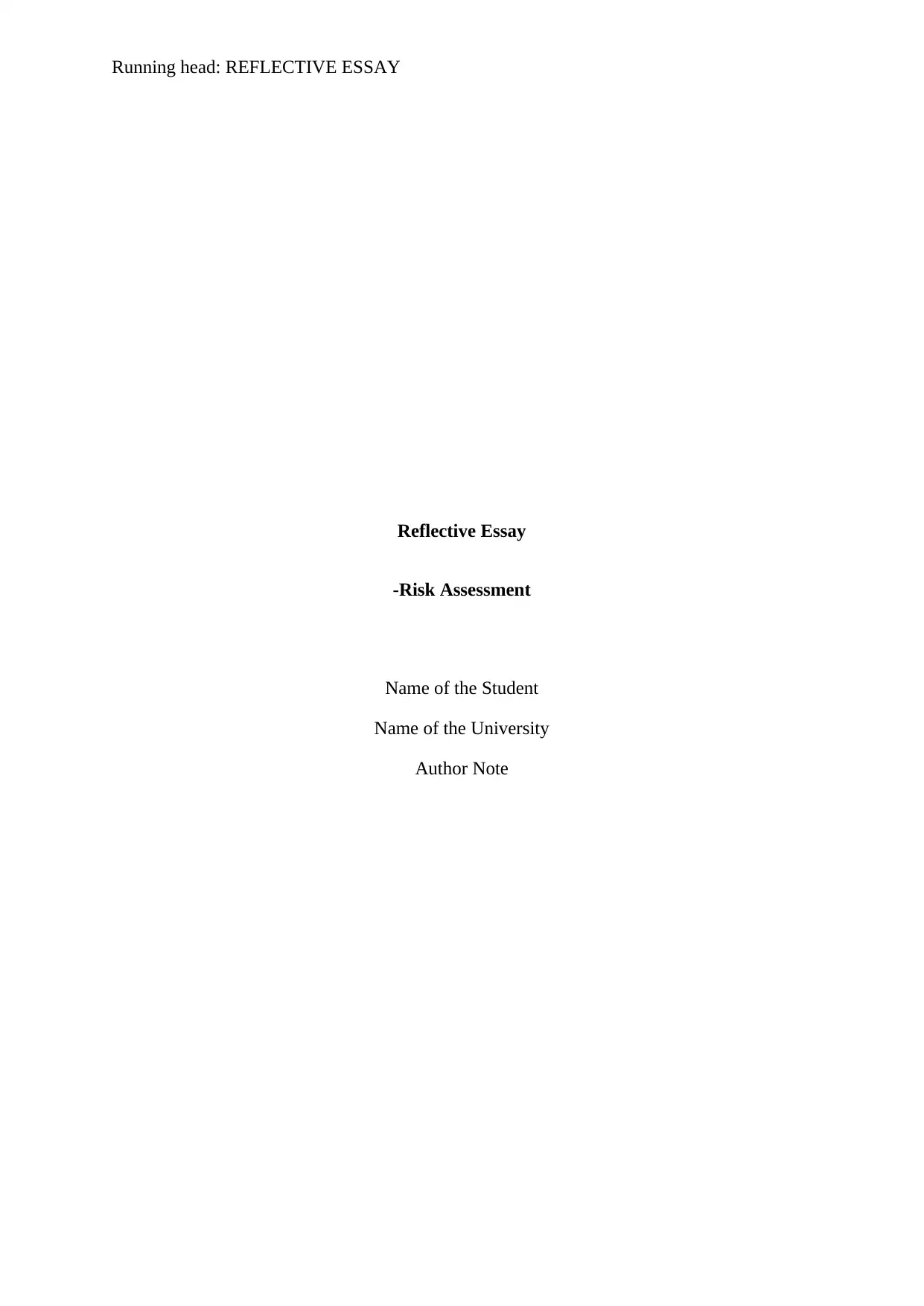
Running head: REFLECTIVE ESSAY
Reflective Essay
-Risk Assessment
Name of the Student
Name of the University
Author Note
Reflective Essay
-Risk Assessment
Name of the Student
Name of the University
Author Note
Paraphrase This Document
Need a fresh take? Get an instant paraphrase of this document with our AI Paraphraser
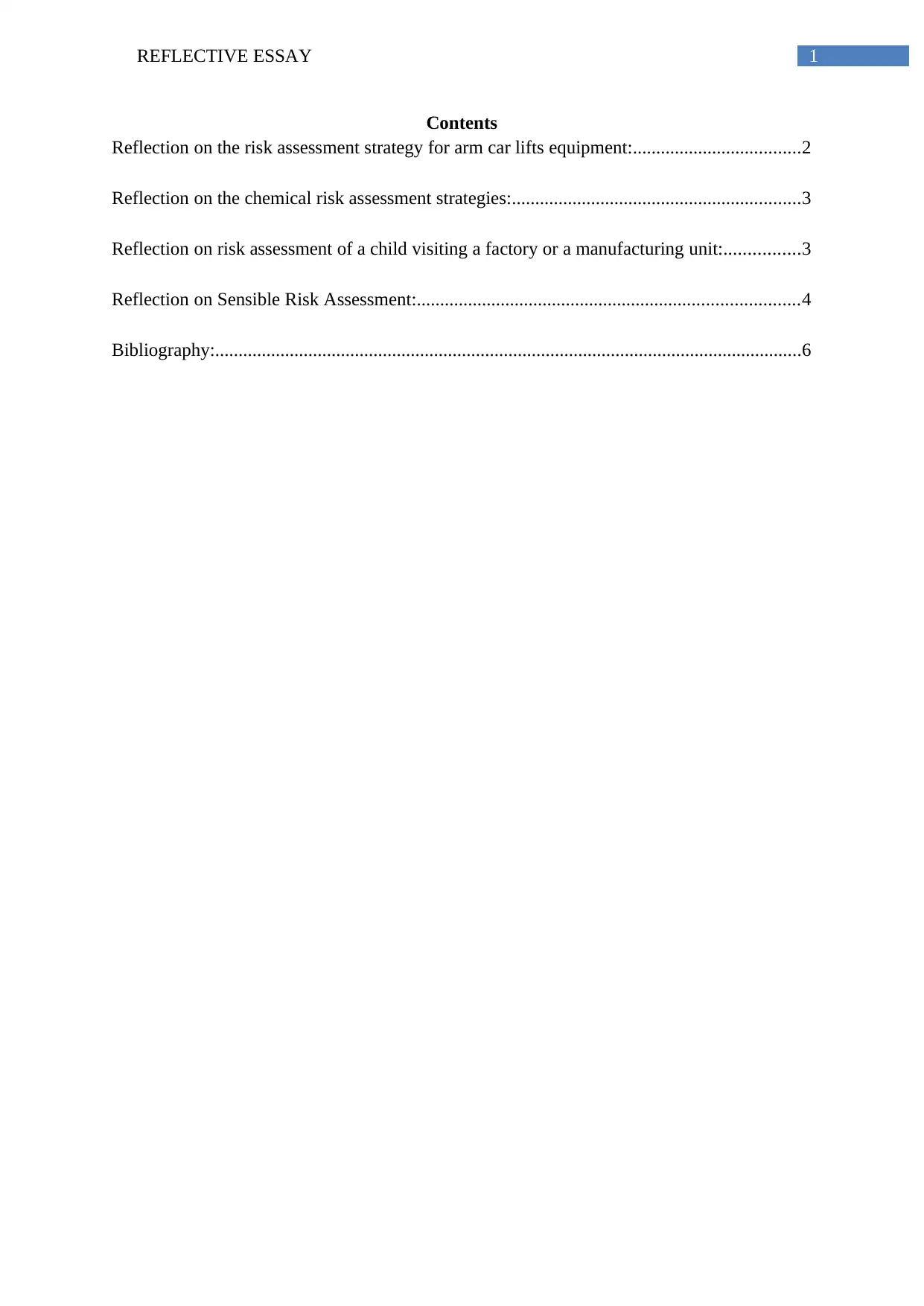
1REFLECTIVE ESSAY
Contents
Reflection on the risk assessment strategy for arm car lifts equipment:....................................2
Reflection on the chemical risk assessment strategies:..............................................................3
Reflection on risk assessment of a child visiting a factory or a manufacturing unit:................3
Reflection on Sensible Risk Assessment:..................................................................................4
Bibliography:..............................................................................................................................6
Contents
Reflection on the risk assessment strategy for arm car lifts equipment:....................................2
Reflection on the chemical risk assessment strategies:..............................................................3
Reflection on risk assessment of a child visiting a factory or a manufacturing unit:................3
Reflection on Sensible Risk Assessment:..................................................................................4
Bibliography:..............................................................................................................................6
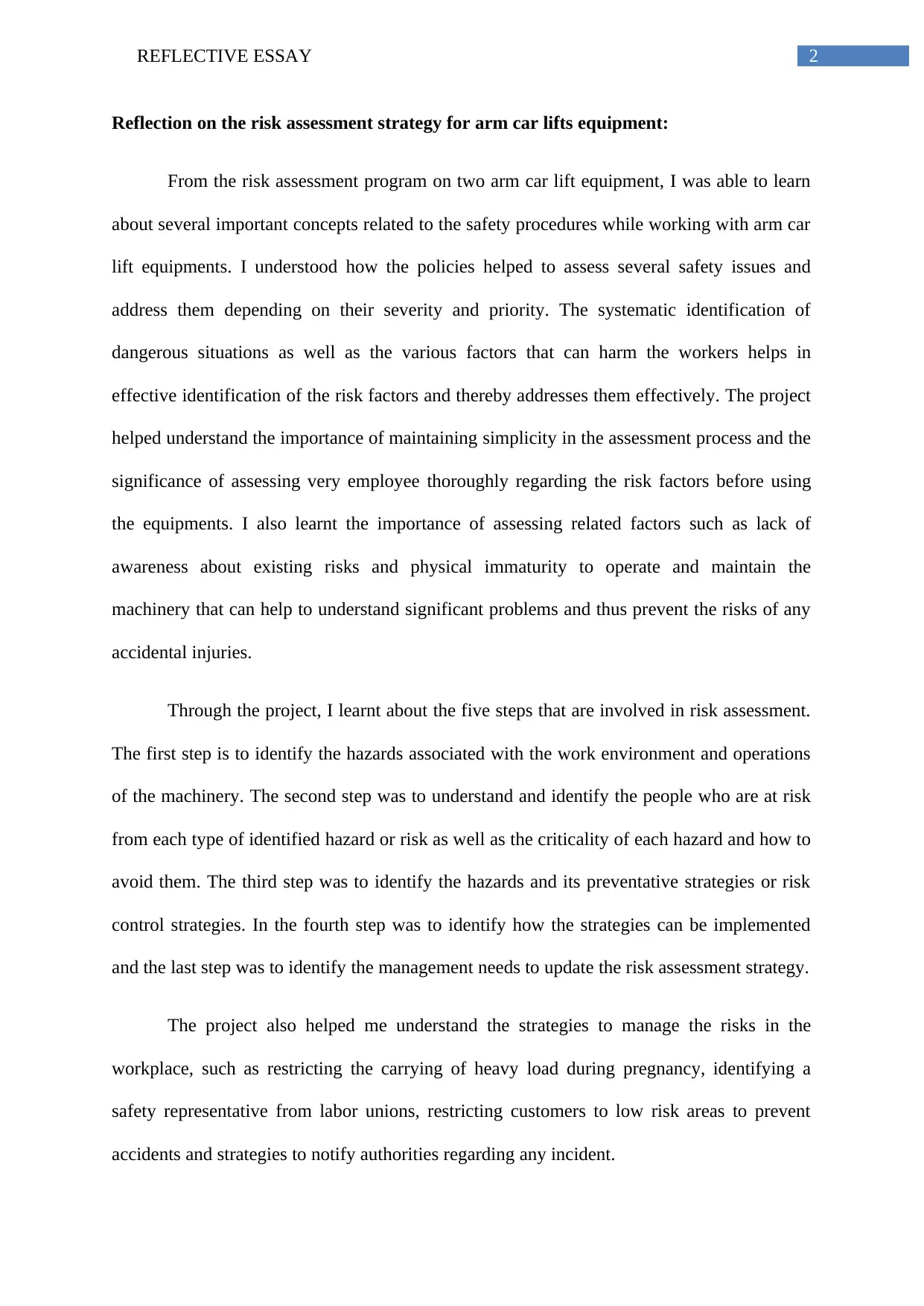
2REFLECTIVE ESSAY
Reflection on the risk assessment strategy for arm car lifts equipment:
From the risk assessment program on two arm car lift equipment, I was able to learn
about several important concepts related to the safety procedures while working with arm car
lift equipments. I understood how the policies helped to assess several safety issues and
address them depending on their severity and priority. The systematic identification of
dangerous situations as well as the various factors that can harm the workers helps in
effective identification of the risk factors and thereby addresses them effectively. The project
helped understand the importance of maintaining simplicity in the assessment process and the
significance of assessing very employee thoroughly regarding the risk factors before using
the equipments. I also learnt the importance of assessing related factors such as lack of
awareness about existing risks and physical immaturity to operate and maintain the
machinery that can help to understand significant problems and thus prevent the risks of any
accidental injuries.
Through the project, I learnt about the five steps that are involved in risk assessment.
The first step is to identify the hazards associated with the work environment and operations
of the machinery. The second step was to understand and identify the people who are at risk
from each type of identified hazard or risk as well as the criticality of each hazard and how to
avoid them. The third step was to identify the hazards and its preventative strategies or risk
control strategies. In the fourth step was to identify how the strategies can be implemented
and the last step was to identify the management needs to update the risk assessment strategy.
The project also helped me understand the strategies to manage the risks in the
workplace, such as restricting the carrying of heavy load during pregnancy, identifying a
safety representative from labor unions, restricting customers to low risk areas to prevent
accidents and strategies to notify authorities regarding any incident.
Reflection on the risk assessment strategy for arm car lifts equipment:
From the risk assessment program on two arm car lift equipment, I was able to learn
about several important concepts related to the safety procedures while working with arm car
lift equipments. I understood how the policies helped to assess several safety issues and
address them depending on their severity and priority. The systematic identification of
dangerous situations as well as the various factors that can harm the workers helps in
effective identification of the risk factors and thereby addresses them effectively. The project
helped understand the importance of maintaining simplicity in the assessment process and the
significance of assessing very employee thoroughly regarding the risk factors before using
the equipments. I also learnt the importance of assessing related factors such as lack of
awareness about existing risks and physical immaturity to operate and maintain the
machinery that can help to understand significant problems and thus prevent the risks of any
accidental injuries.
Through the project, I learnt about the five steps that are involved in risk assessment.
The first step is to identify the hazards associated with the work environment and operations
of the machinery. The second step was to understand and identify the people who are at risk
from each type of identified hazard or risk as well as the criticality of each hazard and how to
avoid them. The third step was to identify the hazards and its preventative strategies or risk
control strategies. In the fourth step was to identify how the strategies can be implemented
and the last step was to identify the management needs to update the risk assessment strategy.
The project also helped me understand the strategies to manage the risks in the
workplace, such as restricting the carrying of heavy load during pregnancy, identifying a
safety representative from labor unions, restricting customers to low risk areas to prevent
accidents and strategies to notify authorities regarding any incident.
⊘ This is a preview!⊘
Do you want full access?
Subscribe today to unlock all pages.

Trusted by 1+ million students worldwide
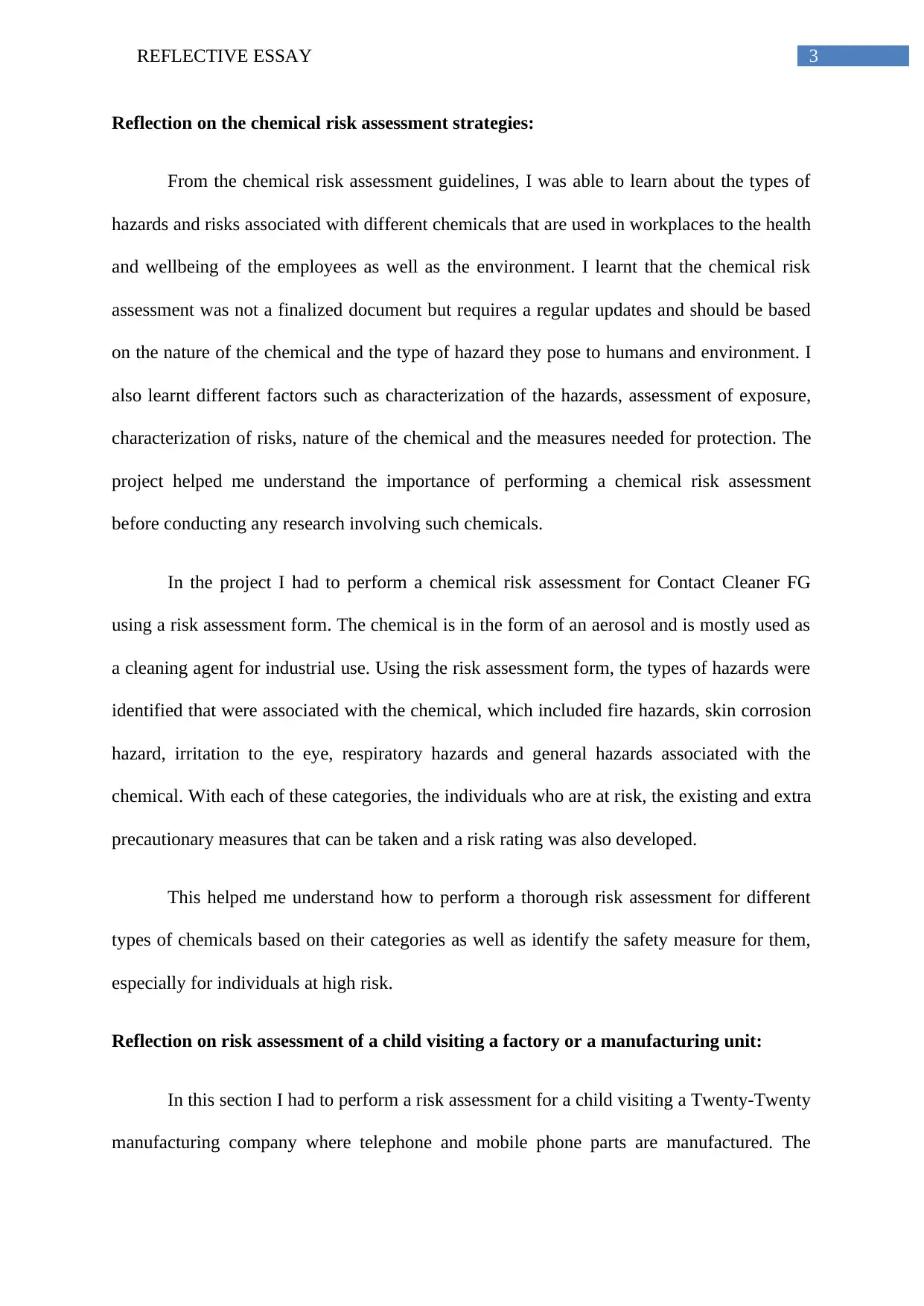
3REFLECTIVE ESSAY
Reflection on the chemical risk assessment strategies:
From the chemical risk assessment guidelines, I was able to learn about the types of
hazards and risks associated with different chemicals that are used in workplaces to the health
and wellbeing of the employees as well as the environment. I learnt that the chemical risk
assessment was not a finalized document but requires a regular updates and should be based
on the nature of the chemical and the type of hazard they pose to humans and environment. I
also learnt different factors such as characterization of the hazards, assessment of exposure,
characterization of risks, nature of the chemical and the measures needed for protection. The
project helped me understand the importance of performing a chemical risk assessment
before conducting any research involving such chemicals.
In the project I had to perform a chemical risk assessment for Contact Cleaner FG
using a risk assessment form. The chemical is in the form of an aerosol and is mostly used as
a cleaning agent for industrial use. Using the risk assessment form, the types of hazards were
identified that were associated with the chemical, which included fire hazards, skin corrosion
hazard, irritation to the eye, respiratory hazards and general hazards associated with the
chemical. With each of these categories, the individuals who are at risk, the existing and extra
precautionary measures that can be taken and a risk rating was also developed.
This helped me understand how to perform a thorough risk assessment for different
types of chemicals based on their categories as well as identify the safety measure for them,
especially for individuals at high risk.
Reflection on risk assessment of a child visiting a factory or a manufacturing unit:
In this section I had to perform a risk assessment for a child visiting a Twenty-Twenty
manufacturing company where telephone and mobile phone parts are manufactured. The
Reflection on the chemical risk assessment strategies:
From the chemical risk assessment guidelines, I was able to learn about the types of
hazards and risks associated with different chemicals that are used in workplaces to the health
and wellbeing of the employees as well as the environment. I learnt that the chemical risk
assessment was not a finalized document but requires a regular updates and should be based
on the nature of the chemical and the type of hazard they pose to humans and environment. I
also learnt different factors such as characterization of the hazards, assessment of exposure,
characterization of risks, nature of the chemical and the measures needed for protection. The
project helped me understand the importance of performing a chemical risk assessment
before conducting any research involving such chemicals.
In the project I had to perform a chemical risk assessment for Contact Cleaner FG
using a risk assessment form. The chemical is in the form of an aerosol and is mostly used as
a cleaning agent for industrial use. Using the risk assessment form, the types of hazards were
identified that were associated with the chemical, which included fire hazards, skin corrosion
hazard, irritation to the eye, respiratory hazards and general hazards associated with the
chemical. With each of these categories, the individuals who are at risk, the existing and extra
precautionary measures that can be taken and a risk rating was also developed.
This helped me understand how to perform a thorough risk assessment for different
types of chemicals based on their categories as well as identify the safety measure for them,
especially for individuals at high risk.
Reflection on risk assessment of a child visiting a factory or a manufacturing unit:
In this section I had to perform a risk assessment for a child visiting a Twenty-Twenty
manufacturing company where telephone and mobile phone parts are manufactured. The
Paraphrase This Document
Need a fresh take? Get an instant paraphrase of this document with our AI Paraphraser
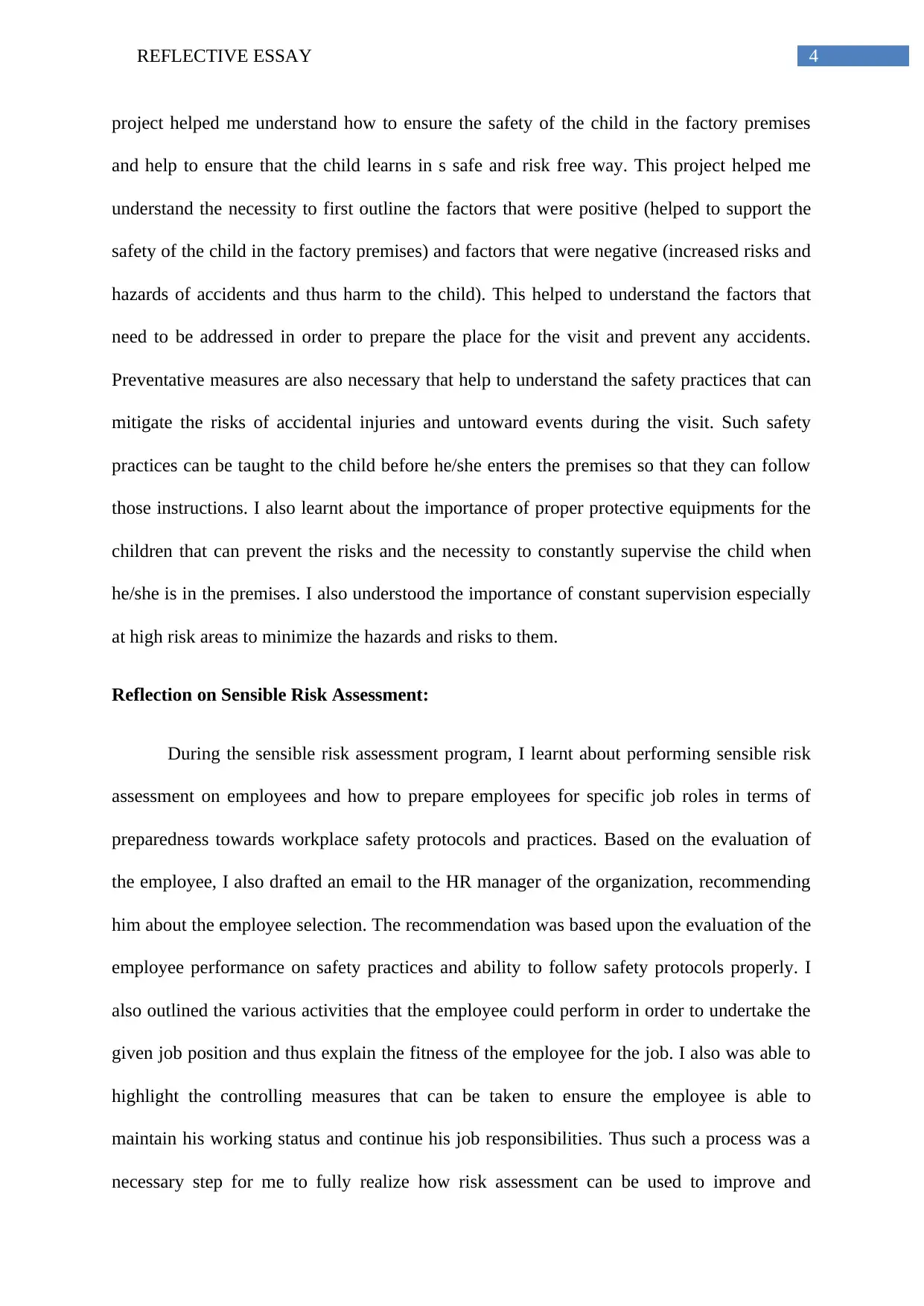
4REFLECTIVE ESSAY
project helped me understand how to ensure the safety of the child in the factory premises
and help to ensure that the child learns in s safe and risk free way. This project helped me
understand the necessity to first outline the factors that were positive (helped to support the
safety of the child in the factory premises) and factors that were negative (increased risks and
hazards of accidents and thus harm to the child). This helped to understand the factors that
need to be addressed in order to prepare the place for the visit and prevent any accidents.
Preventative measures are also necessary that help to understand the safety practices that can
mitigate the risks of accidental injuries and untoward events during the visit. Such safety
practices can be taught to the child before he/she enters the premises so that they can follow
those instructions. I also learnt about the importance of proper protective equipments for the
children that can prevent the risks and the necessity to constantly supervise the child when
he/she is in the premises. I also understood the importance of constant supervision especially
at high risk areas to minimize the hazards and risks to them.
Reflection on Sensible Risk Assessment:
During the sensible risk assessment program, I learnt about performing sensible risk
assessment on employees and how to prepare employees for specific job roles in terms of
preparedness towards workplace safety protocols and practices. Based on the evaluation of
the employee, I also drafted an email to the HR manager of the organization, recommending
him about the employee selection. The recommendation was based upon the evaluation of the
employee performance on safety practices and ability to follow safety protocols properly. I
also outlined the various activities that the employee could perform in order to undertake the
given job position and thus explain the fitness of the employee for the job. I also was able to
highlight the controlling measures that can be taken to ensure the employee is able to
maintain his working status and continue his job responsibilities. Thus such a process was a
necessary step for me to fully realize how risk assessment can be used to improve and
project helped me understand how to ensure the safety of the child in the factory premises
and help to ensure that the child learns in s safe and risk free way. This project helped me
understand the necessity to first outline the factors that were positive (helped to support the
safety of the child in the factory premises) and factors that were negative (increased risks and
hazards of accidents and thus harm to the child). This helped to understand the factors that
need to be addressed in order to prepare the place for the visit and prevent any accidents.
Preventative measures are also necessary that help to understand the safety practices that can
mitigate the risks of accidental injuries and untoward events during the visit. Such safety
practices can be taught to the child before he/she enters the premises so that they can follow
those instructions. I also learnt about the importance of proper protective equipments for the
children that can prevent the risks and the necessity to constantly supervise the child when
he/she is in the premises. I also understood the importance of constant supervision especially
at high risk areas to minimize the hazards and risks to them.
Reflection on Sensible Risk Assessment:
During the sensible risk assessment program, I learnt about performing sensible risk
assessment on employees and how to prepare employees for specific job roles in terms of
preparedness towards workplace safety protocols and practices. Based on the evaluation of
the employee, I also drafted an email to the HR manager of the organization, recommending
him about the employee selection. The recommendation was based upon the evaluation of the
employee performance on safety practices and ability to follow safety protocols properly. I
also outlined the various activities that the employee could perform in order to undertake the
given job position and thus explain the fitness of the employee for the job. I also was able to
highlight the controlling measures that can be taken to ensure the employee is able to
maintain his working status and continue his job responsibilities. Thus such a process was a
necessary step for me to fully realize how risk assessment can be used to improve and
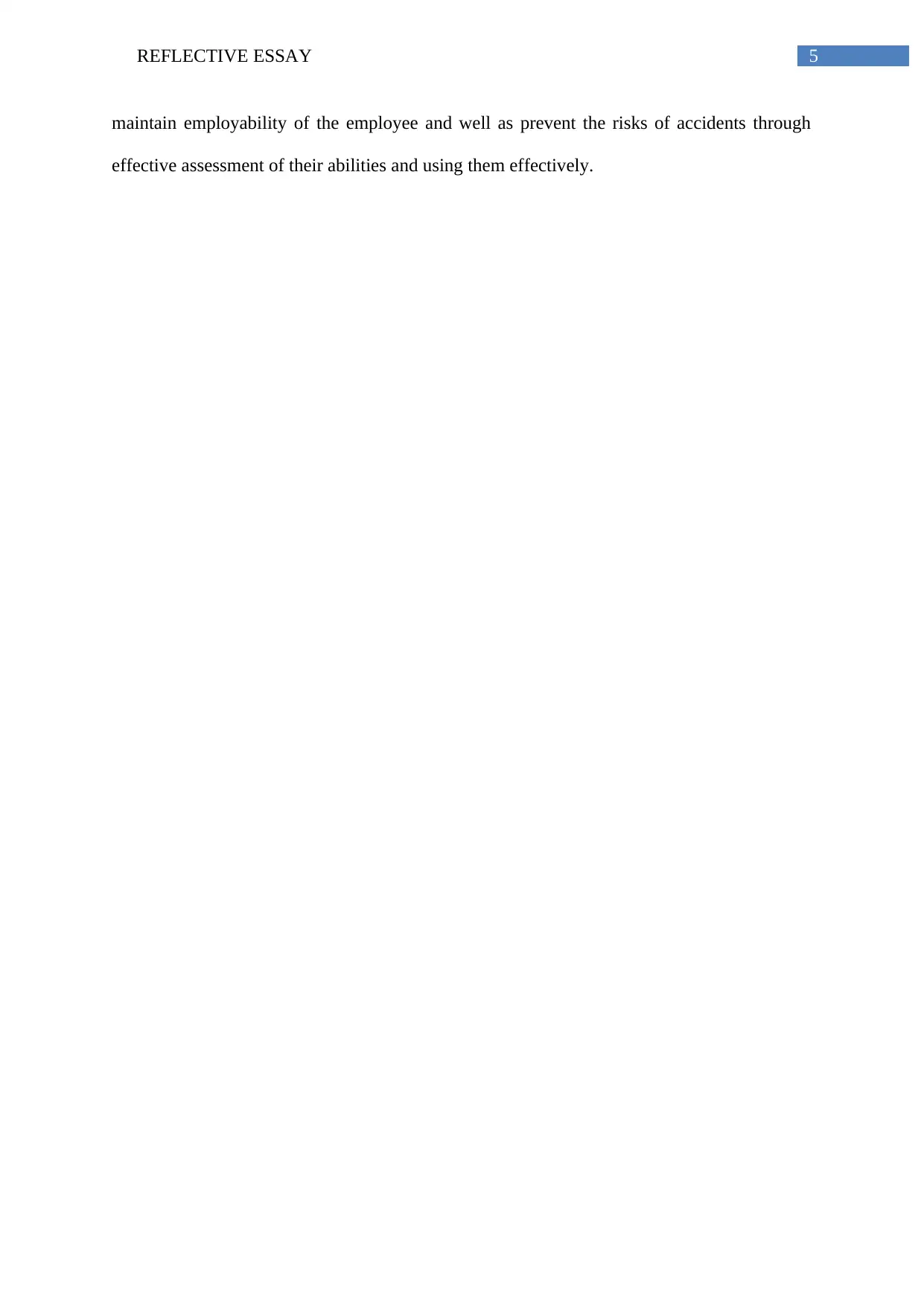
5REFLECTIVE ESSAY
maintain employability of the employee and well as prevent the risks of accidents through
effective assessment of their abilities and using them effectively.
maintain employability of the employee and well as prevent the risks of accidents through
effective assessment of their abilities and using them effectively.
⊘ This is a preview!⊘
Do you want full access?
Subscribe today to unlock all pages.

Trusted by 1+ million students worldwide
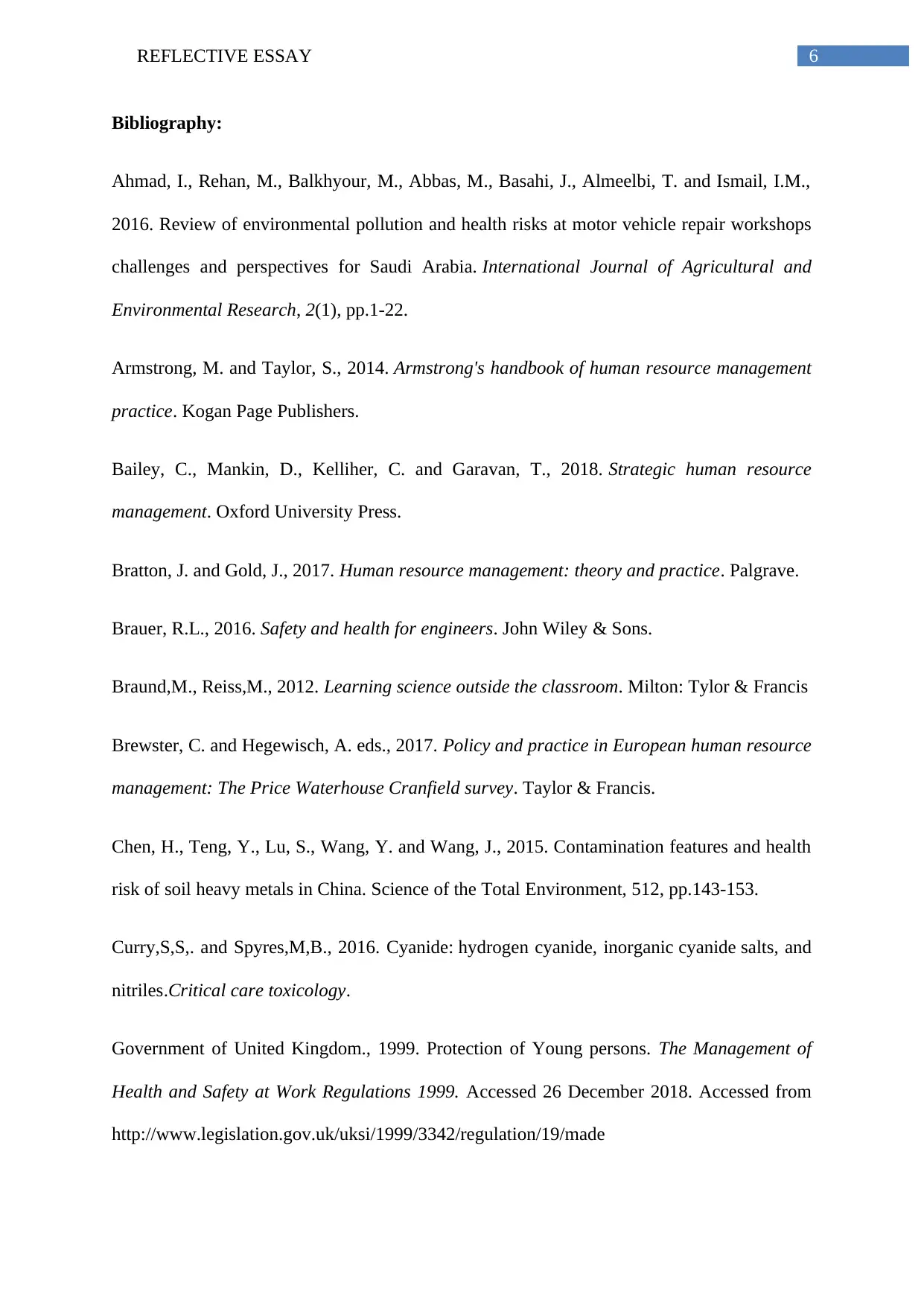
6REFLECTIVE ESSAY
Bibliography:
Ahmad, I., Rehan, M., Balkhyour, M., Abbas, M., Basahi, J., Almeelbi, T. and Ismail, I.M.,
2016. Review of environmental pollution and health risks at motor vehicle repair workshops
challenges and perspectives for Saudi Arabia. International Journal of Agricultural and
Environmental Research, 2(1), pp.1-22.
Armstrong, M. and Taylor, S., 2014. Armstrong's handbook of human resource management
practice. Kogan Page Publishers.
Bailey, C., Mankin, D., Kelliher, C. and Garavan, T., 2018. Strategic human resource
management. Oxford University Press.
Bratton, J. and Gold, J., 2017. Human resource management: theory and practice. Palgrave.
Brauer, R.L., 2016. Safety and health for engineers. John Wiley & Sons.
Braund,M., Reiss,M., 2012. Learning science outside the classroom. Milton: Tylor & Francis
Brewster, C. and Hegewisch, A. eds., 2017. Policy and practice in European human resource
management: The Price Waterhouse Cranfield survey. Taylor & Francis.
Chen, H., Teng, Y., Lu, S., Wang, Y. and Wang, J., 2015. Contamination features and health
risk of soil heavy metals in China. Science of the Total Environment, 512, pp.143-153.
Curry,S,S,. and Spyres,M,B., 2016. Cyanide: hydrogen cyanide, inorganic cyanide salts, and
nitriles.Critical care toxicology.
Government of United Kingdom., 1999. Protection of Young persons. The Management of
Health and Safety at Work Regulations 1999. Accessed 26 December 2018. Accessed from
http://www.legislation.gov.uk/uksi/1999/3342/regulation/19/made
Bibliography:
Ahmad, I., Rehan, M., Balkhyour, M., Abbas, M., Basahi, J., Almeelbi, T. and Ismail, I.M.,
2016. Review of environmental pollution and health risks at motor vehicle repair workshops
challenges and perspectives for Saudi Arabia. International Journal of Agricultural and
Environmental Research, 2(1), pp.1-22.
Armstrong, M. and Taylor, S., 2014. Armstrong's handbook of human resource management
practice. Kogan Page Publishers.
Bailey, C., Mankin, D., Kelliher, C. and Garavan, T., 2018. Strategic human resource
management. Oxford University Press.
Bratton, J. and Gold, J., 2017. Human resource management: theory and practice. Palgrave.
Brauer, R.L., 2016. Safety and health for engineers. John Wiley & Sons.
Braund,M., Reiss,M., 2012. Learning science outside the classroom. Milton: Tylor & Francis
Brewster, C. and Hegewisch, A. eds., 2017. Policy and practice in European human resource
management: The Price Waterhouse Cranfield survey. Taylor & Francis.
Chen, H., Teng, Y., Lu, S., Wang, Y. and Wang, J., 2015. Contamination features and health
risk of soil heavy metals in China. Science of the Total Environment, 512, pp.143-153.
Curry,S,S,. and Spyres,M,B., 2016. Cyanide: hydrogen cyanide, inorganic cyanide salts, and
nitriles.Critical care toxicology.
Government of United Kingdom., 1999. Protection of Young persons. The Management of
Health and Safety at Work Regulations 1999. Accessed 26 December 2018. Accessed from
http://www.legislation.gov.uk/uksi/1999/3342/regulation/19/made
Paraphrase This Document
Need a fresh take? Get an instant paraphrase of this document with our AI Paraphraser
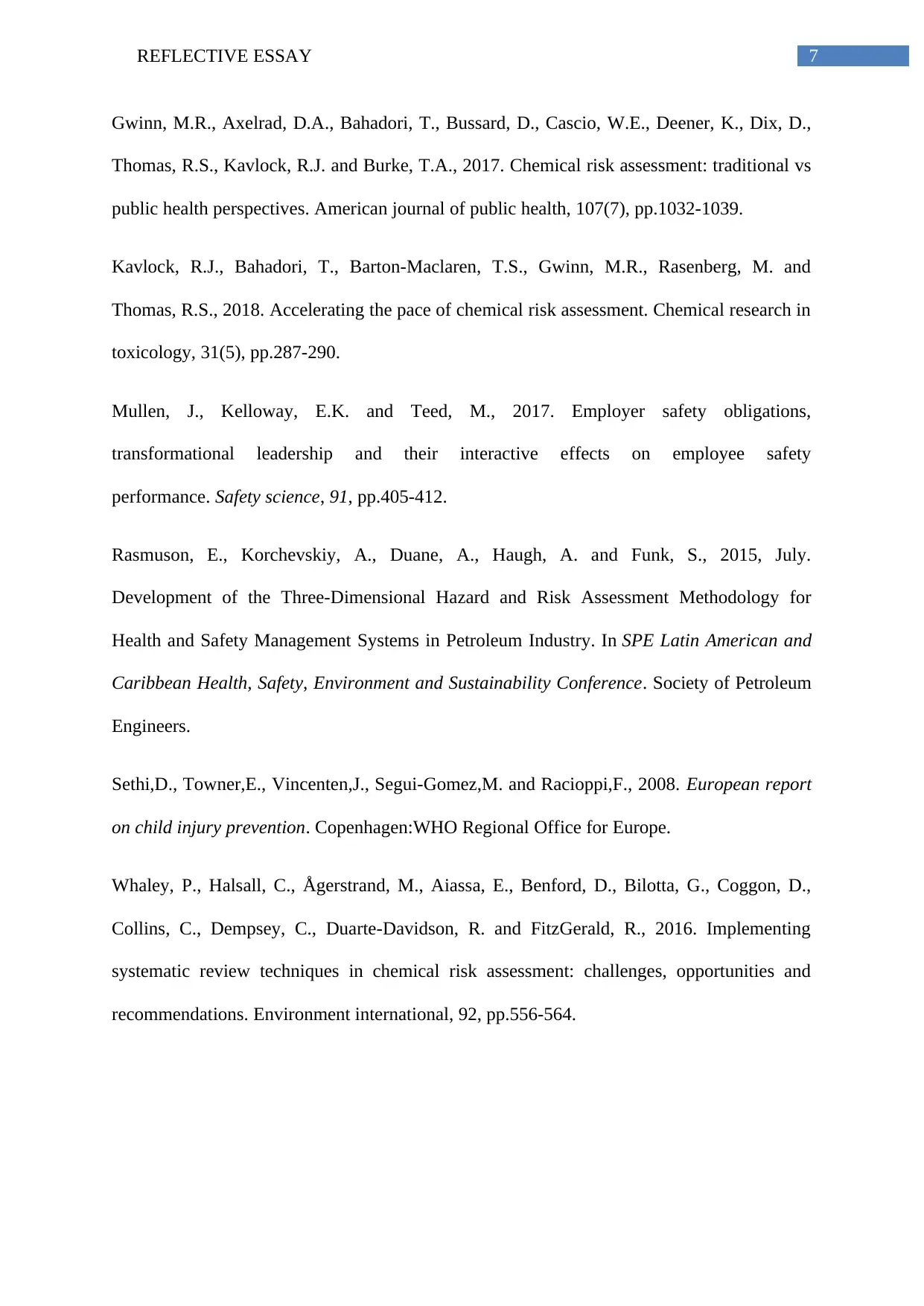
7REFLECTIVE ESSAY
Gwinn, M.R., Axelrad, D.A., Bahadori, T., Bussard, D., Cascio, W.E., Deener, K., Dix, D.,
Thomas, R.S., Kavlock, R.J. and Burke, T.A., 2017. Chemical risk assessment: traditional vs
public health perspectives. American journal of public health, 107(7), pp.1032-1039.
Kavlock, R.J., Bahadori, T., Barton-Maclaren, T.S., Gwinn, M.R., Rasenberg, M. and
Thomas, R.S., 2018. Accelerating the pace of chemical risk assessment. Chemical research in
toxicology, 31(5), pp.287-290.
Mullen, J., Kelloway, E.K. and Teed, M., 2017. Employer safety obligations,
transformational leadership and their interactive effects on employee safety
performance. Safety science, 91, pp.405-412.
Rasmuson, E., Korchevskiy, A., Duane, A., Haugh, A. and Funk, S., 2015, July.
Development of the Three-Dimensional Hazard and Risk Assessment Methodology for
Health and Safety Management Systems in Petroleum Industry. In SPE Latin American and
Caribbean Health, Safety, Environment and Sustainability Conference. Society of Petroleum
Engineers.
Sethi,D., Towner,E., Vincenten,J., Segui-Gomez,M. and Racioppi,F., 2008. European report
on child injury prevention. Copenhagen:WHO Regional Office for Europe.
Whaley, P., Halsall, C., Ågerstrand, M., Aiassa, E., Benford, D., Bilotta, G., Coggon, D.,
Collins, C., Dempsey, C., Duarte-Davidson, R. and FitzGerald, R., 2016. Implementing
systematic review techniques in chemical risk assessment: challenges, opportunities and
recommendations. Environment international, 92, pp.556-564.
Gwinn, M.R., Axelrad, D.A., Bahadori, T., Bussard, D., Cascio, W.E., Deener, K., Dix, D.,
Thomas, R.S., Kavlock, R.J. and Burke, T.A., 2017. Chemical risk assessment: traditional vs
public health perspectives. American journal of public health, 107(7), pp.1032-1039.
Kavlock, R.J., Bahadori, T., Barton-Maclaren, T.S., Gwinn, M.R., Rasenberg, M. and
Thomas, R.S., 2018. Accelerating the pace of chemical risk assessment. Chemical research in
toxicology, 31(5), pp.287-290.
Mullen, J., Kelloway, E.K. and Teed, M., 2017. Employer safety obligations,
transformational leadership and their interactive effects on employee safety
performance. Safety science, 91, pp.405-412.
Rasmuson, E., Korchevskiy, A., Duane, A., Haugh, A. and Funk, S., 2015, July.
Development of the Three-Dimensional Hazard and Risk Assessment Methodology for
Health and Safety Management Systems in Petroleum Industry. In SPE Latin American and
Caribbean Health, Safety, Environment and Sustainability Conference. Society of Petroleum
Engineers.
Sethi,D., Towner,E., Vincenten,J., Segui-Gomez,M. and Racioppi,F., 2008. European report
on child injury prevention. Copenhagen:WHO Regional Office for Europe.
Whaley, P., Halsall, C., Ågerstrand, M., Aiassa, E., Benford, D., Bilotta, G., Coggon, D.,
Collins, C., Dempsey, C., Duarte-Davidson, R. and FitzGerald, R., 2016. Implementing
systematic review techniques in chemical risk assessment: challenges, opportunities and
recommendations. Environment international, 92, pp.556-564.
1 out of 8
Related Documents
Your All-in-One AI-Powered Toolkit for Academic Success.
+13062052269
info@desklib.com
Available 24*7 on WhatsApp / Email
![[object Object]](/_next/static/media/star-bottom.7253800d.svg)
Unlock your academic potential
Copyright © 2020–2025 A2Z Services. All Rights Reserved. Developed and managed by ZUCOL.





